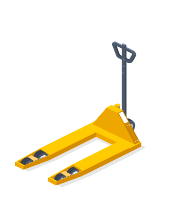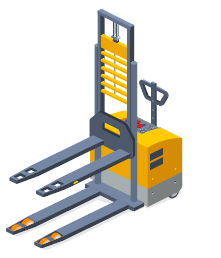Pallet Jacks
What is a pallet jack?
A pallet jack (aka pallet truck, pallet pump, or pump truck) is a type of material handling forklift used to easily and conveniently lift and move “pallets” of materials, such as inventory, that cannot easily be moved manually.
Pallet jacks are one of the most basic and commonly used types of material handling equipment, and are very frequently used in warehouses, manufacturing, and retail settings. They are an ideal piece of warehouse equipment because they:
- Move material across short/long distances quickly
- Can be easily maneuvered
- Are very affordable (including maintenance)
- Reduce risk of injuries and inventory damage
Pallet jacks can typically lift materials up to 1-2 ft. (8 ft. max), whereas order pickers can help warehouse workers reach heights of up to 35 feet.
Where are pallet jacks typically used?
Pallet jacks are most commonly used in retail and warehouse settings. However, there are a few other industries that reap the benefits of a pallet jack as well.
- Warehouses
- Retail locations
- Manufacturing facilities
- Construction sites
- Automotive locations
- Storage facilities
- Food and beverage
- Lumber companies
Essentially, a pallet jack is a simple forklift that can be used anywhere commercial materials need to be moved around frequently. They can be used to load and unload truck shipments, raise items to storage shelves, or relocating heavy items from the ground to a higher location.
How do they work?
Pallet jacks – both manual and electric versions – are one of the most simple forklifts and are very easy to use.
- Pallet jacks have two “forks” that sit at the ground level when not being used. These forks can be inserted underneath material or a load of pallets.
- The pallet jack has a large lever or handle that workers can push to lower or raise the jack. This handle releases hydraulic fluid, which allows the jack to lift to its height capacity.
- Lastly, pallet jacks have wheels in the front which allow workers to easily maneuver the jack around the workplace.
Types of pallet jacks
There are 3 main types of pallet jacks that are typically used for commercial purposes. Note that each of these pallet jacks are used for different industry and movement purposes, so make sure to find the one that fits your needs.
Manual pallet jack
Manual pallet jacks are hand-powered machines, and the most commonly used type of pallet jack in warehouse and retail settings. They are typically used for horizontal movement, rather than lifting cargo to an elevated height. They are designed to lift wooden “pallets” of material, and carry lightweight to medium weight cargo over short distances without injuring or straining the worker.

Most manual pallet jacks use a mechanical pump-operated system. Essentially, the user will “push” on a lever to raise the pallet jack’s forks off the ground and lift the cargo upward. Then, once the cargo has been lifted efficiently, the user can squeeze on the lever to lower the forks back to the ground.
- Power source: Mechanical hand-powered hydraulic pump
- Load capacity: 1,000-5,500 lbs. (depending on the make and model)
- Height capacity: Around 7” off the ground
- Typical industry uses: Warehouse, manufacturing
- Typical applications: Basic inventory tasks, such as moving a stack of cargo onto a loading dock or moving pallets onto a warehouse shelf
Electric (powered) pallet jack
In contrast to a hand-powered manual pallet jack, an electrical pallet jack (aka powered pallet jack, pallet truck, or walkie) has an electrical motor and can be used to lift heavier cargo or stacks of cargo. Many electric pallet jacks also have a platform behind the jack’s handle, which the user can stand on to operate the machine.

Electric pallet jacks usually have a handle with a throttle or button that helps move the cargo loaded onto the jack. Then, the user can “steer” the handle to move in the direction they need. Many electric pallet jacks contain an emergency switch, which can be pulled to stop the electric jack in the case of an emergency.
- Power source: Electric (battery-powered) motor
- Load capacity: 4,500-5,500 lbs. (depending on the make and model)
- Height capacity: Around 7”+ off the ground (depending on the make and model)
- Typical industry uses: Warehouse, manufacturing, industrial
- Typical applications: Moving heavier warehouse inventory, which can’t be moved safely with a hand-powered device
Rough terrain pallet jack
Rough terrain pallet jacks (or “all terrain” pallet jacks) are less frequently used compared to manual and electric pallet jacks. They are used to lift heavy materials on an uneven ground, such as outdoors.

Rough terrain pallet jacks also frequently have larger, water-tight, smooth-rolling wheels to comfortably for uneven surfaces, such as gravel. Their forks can usually be adjusted for materials of different sizes.
- Power source: Electric (battery-powered) or gas
- Load capacity: 2,000-5,500 lbs. (depending on the make and model)
- Height capacity: Around 7”+ off the ground (depending on the make and model)
- Industry uses: Construction sites, garden centers, and other outdoor applications.
- Typical applications: Moving heavier materials in outdoor, all-terrain setting
Pallet jack dimensions and weight capacity
| Fork Width | Fork Length | Lowered height | Raised Height | Weight capacity |
| Each fork: 7” Width across two forks: 20-27” | 36”, 42”, or 48” available | About 2.9” | 7.5” minimum 8 feet maximum | 4,500-5,500 lbs. |
Factors to consider before buying
Because every pallet jack is slightly different depending on the manufacturer (make and model), it’s important to look closely at certain factors before buying. This will help you ensure you are buying or renting the best pallet jack for your specific needs. Consider the following before making a final decision.
1. Weight capacity
Pay close attention to the maximum weight capacity that the pallet jack can hold. This is crucial because it will determine whether or not the forklift will be able to carry your materials. The last thing you want is to overload the pallet jack and cause machine damage or an employee injury. Some pallet jacks can accommodate up to 5,500 lbs. but every machine is different. Electric jacks can usually carry more weight than manual jacks. Also make sure to consider the weight of the pallet jack itself, as you need to ensure your work setting and surfaces will be able to support the weight. If you have concerns about weight capacity, make sure to speak with your supplier.
2. Wheels
We recommend looking for a pallet jack with non-staining polyurethane wheels. This should ensure the pallet jack won’t stain or damage warehouse floors as your wheeling the jack from one place to another. Beware of jacks with cheaper, low-quality wheels, as they can create damage and often cause a lower weight capacity.
3. Maximum raised height
Make sure to check the pallet jack’s maximum raised height, or “lift height.” This will tell you how high the pallet jack is able to lift materials. Pallet jacks have a wide range of maximum lift heights depending on the specific machine. They can range anywhere from 3” off the floor to as high as 8 feet. We recommend taking exact measurements in your workplace and comparing them to the maximum raised height of the jack to make sure it can accommodate your lift needs.
How much does it cost to rent or buy a pallet jack?
Pallet jacks are one of the most affordable types of material handling forklifts. The cost of a pallet jack depends on the size, weight capacity, maximum raised height, and more. Also note that manual pallet jacks will be the most affordable, whereas electric and rough terrain pallet jacks tend to be more expensive, comparatively.
| Rentals | Purchase |
| $200-$800 per month, depending on type of jack | Low budget (ie. mini, manual): $150-$250 Medium budget (ie. electric): $400-$800 High budget (ie. rough terrain): $1,000-$2,000 |
- When to rent: You should consider renting if you need the pallet jack for a temporary duration of time, such as seasonal needs. As long as you are using the pallet jack for a short duration of time, you should save more money by renting. However, make sure to talk to your supplier about monthly rental costs as well as any other additional costs associated with renting. You may get a better value out of purchasing and reselling the machine once you’re finished using it.
- When to purchase: If you plan to need the pallet jack over a longer period of time (ie. one year or more), your best bet is to buy. Pallet jacks are very affordable to buy as it is. So if you need the pallet jack for a year or more, you will actually pay more in rental fees than to buy the machine outright. Remember you can always resell the pallet jack once you no longer need it.
To explore rental and purchase options, make sure to use our free comparison tool to get free quotes on pallet jacks and save up to 30%!
